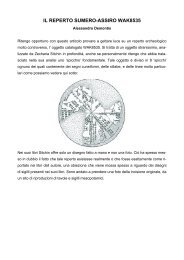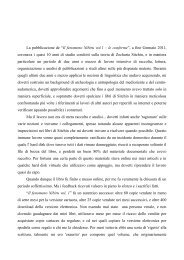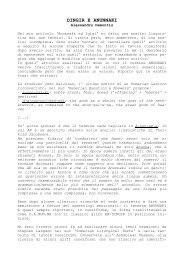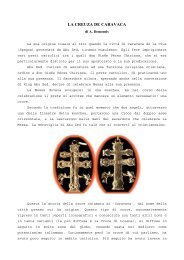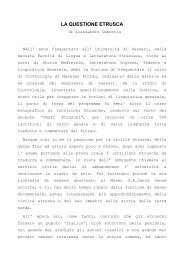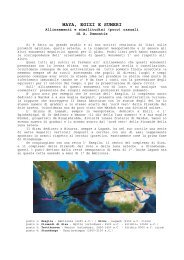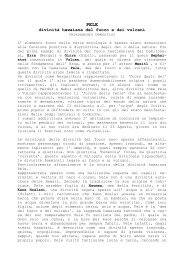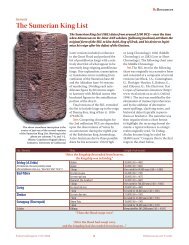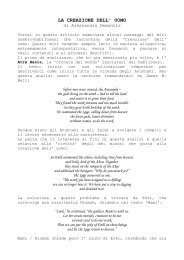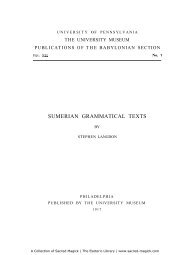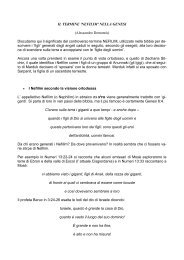ANUNNAKI AND IGIGI, a linguistic overview
ANUNNAKI AND IGIGI, a linguistic overview
ANUNNAKI AND IGIGI, a linguistic overview
You also want an ePaper? Increase the reach of your titles
YUMPU automatically turns print PDFs into web optimized ePapers that Google loves.
<strong>ANUNNAKI</strong> <strong>AND</strong> <strong>IGIGI</strong>, a <strong>linguistic</strong> <strong>overview</strong><br />
Alessandro Demontis<br />
Anunnaki e Igigi are two recurring terms in mesopotamic mythology,<br />
describing what we now conseder as having been sumerian and akkadian<br />
deities.<br />
These terms, particularly Anunnaki, are used in both sumerian and<br />
babylonian literature, this latter using the sumerian words and<br />
glyphs instead of the proper babilonian ones. This makes hard to<br />
determine what or who the Anunnaki really were, because the ethimology<br />
of the word is uncertain.<br />
In myths, Anunnaki are often described as the ‘gods of the netherworld’,<br />
with a negative or violent approach, e.g. in the myth<br />
known as “the descent of Inanna to the netherworld” where her sister<br />
Ereshkigal unleashes the Anunnaki to kill her; sometimes they<br />
are depicted as workers in the underground world, miners, and many<br />
other times as some sort of ‘sages’, wisemen of the ‘Council of<br />
Twelve’ having such a role as ‘regulators’ of the life for humankind.<br />
In some other myths we find the Anunnaki waging battles<br />
against each others, occasionally with the partnership of certain<br />
human kings.<br />
The name Igigi instead is less used, and it almost always describes<br />
a portion of the Anunnaki (300 of them, as we read in the<br />
Enuma Elish) residing in Heaven and who occasionally went down to<br />
Earth (KI), as in the tale about Marduk marrying Sarpanit.<br />
We should notice by now that there is a parallel between the Anunnaki<br />
of Sumerian mythology and the Nefilim of semitic / biblic<br />
traditions. Infact the Hebrew root NFL has a meaning that is not<br />
only ‘to fall’, but also ‘to descend’. Tranlating the Nefilim as<br />
‘the one who have descended’ or ‘the ones who descend’, we can integrate<br />
this meaning with the name Anunnaki, that involves the two<br />
Sumerian terms: AN (sky – heaven) and KI (earth – land).<br />
But are the Nephilim ALL the Anunnaki? The answer should be ‘NO’.<br />
The Nephilim are only a part of the Anunnaki, and I consider it<br />
may be significant to identify them with the Igigi.<br />
What I would like to point out in this article is the <strong>linguistic</strong><br />
matter, not the mythological one; all the tries to give an ethimologic<br />
source of the term Anunnaki has been unsuccessful, so that<br />
nowadays we have various version who differ both in the transliteration<br />
and in the involved meanings. Most scholars translate Anunnaki<br />
as ‘Sons of Anu’ or ‘The heirs of Anu’, with Anu being the<br />
chief deity of the Sumerian pantheon, by dividing the term as
An.un[na]. But this translation and the concept it expresses<br />
leaves out the fundamental particle KI.<br />
John Halloran, who pubblished his last Sumerian Lexicon in 2004,<br />
on his website (sumerian questions and answers) proposes:<br />
1) a-nun-na(-k): noble stock; fear, dread ('offspring' + 'master'<br />
+ genitive)<br />
2) d-a-nun-na(-ke4-ne): the gods as a whole; the gods of the netherworld,<br />
as compared to the dnun-gal-e-ne, the great gods of heaven<br />
As we see, the particle KI is completely ignored. In the first definition<br />
the final -K is translated as a genitive case, and in the<br />
second one Halloran proposes that KI would actually be KE4-NE, another<br />
genitive form as reported in his Lexicon:<br />
-ke4: often occurs at the end of a genitival compound which functions<br />
as the actor or agent of the sentence (ak, genitival suffix<br />
'of', + e, ergative agent marker).<br />
Another theory says that Anunnaki must be translitterated as<br />
A.nun.ak.e, where AK is a genitive (this based on Thorkild Jacobsen’s<br />
material).<br />
But how can we trust these translation that have sense only when<br />
letting a particle out of the analysis? These translations would<br />
be acceptable if we ONLY had the form Anunna, which is actually<br />
the most used. In the sumerian period infact we have always Anunna<br />
or Anunna Gods occurring. It is in accadian times that we find the<br />
use of Anunnaki. The fact that this form is used in Akkadian Cuneiform<br />
makes it easy to understand that it may not be an error,<br />
because the term occurs as a non-subordinated form. One who says<br />
that the term AK is always a genitive, and the term Anunnaki is<br />
the genitive case of Anunna, is indirectly saying that everytime<br />
the akkadian scrives used the cuneiform for Anunnaki, rendering<br />
the KI, they were mistaking sumerian grammar and writing. This is<br />
impossibile, because akkadian grammar was mor complex and had more<br />
subordinating particles than sumerian grammar. An error of this<br />
matter could only be made in the opposite case, when we render a<br />
more complex language in a simpler one, because we go to a higher<br />
grade of abstraction.<br />
What is made for sure, in the term Anunnaki, is that the particle<br />
AN means ‘Sky / Heaven’, and the particle KI means ‘Land / Earth’,<br />
so the meaning of the name is something in relation with both heaven<br />
and earth. In my opinion the sumerian term Anunna describes<br />
the ‘gods of heaven’, and the akkadian term Anunnaki describes the<br />
act of these ‘gods of heaven coming on the land’.
It is infact in the akkadian period that we find the term IGI.GI,<br />
this too coming from sumerian roots. The already mentioned Sumerian<br />
Lexicon has:<br />
igi: n., eye(s); glance; face; aspect, looks; front (reduplicated<br />
ig, 'door') [IGI archaic frequency: 21]. v., to see.<br />
gi(4): to surround, besiege; to lock up (circle + to descend<br />
into).<br />
gi(17): n., young man (small and thin like a reed).<br />
By using these rendering and translitteration, we can extend the<br />
‘young man’ meaning to talk about the younger gods, or the ‘to<br />
sorround / besiege’ can be a validation of the concept that Igigi<br />
were described as the gods that remained in the sky, sorrounding<br />
the earth.<br />
Besides, the term IGI.GI could also be a reduplication of the root<br />
IGI = ‘to see’. Infact reduplication of particles was often used<br />
as a plural or to mean an emphasys, like we find in the Flood Tale<br />
when the boat of Ziusudra is called: MA2.GUR.GUR to mean a boat<br />
that can roll and turn upside-down, or the NA4.GUL.GUL in the myth<br />
called «a shir sud to Ninurta». In this case, the emphatic use of<br />
IGI reduplicated is consistent with the meaning of ‘The Watchers’,<br />
the same term used in the Bible to identify the Nefilim.<br />
references:<br />
- The descent of Inanna in the netherworld:<br />
http://etcsl.orinst.ox.ac.uk/cgi-bin/etcsl.cgi?text=t.1.4.1&charenc=j#<br />
- John Halloran’s Sumerian questions and answers - Anunnaki and<br />
Igigi:<br />
http://www.sumerian.org/sumerfaq.htm#s97<br />
- John Hallorans’s Sumerian Lexicon:<br />
http://www.sumerian.org/sumerlex.htm<br />
- Enuma Elish:<br />
http://www.bibliotecapleyades.net/sumer_anunnaki/esp_sumer_annunaki01.htm



